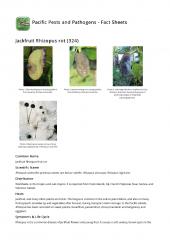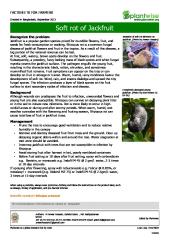Jackfruit or Artocarpus heterophyllus is a tropical evergreen tree that grows up to 20 m in height. It has one or two main trunks with a smooth and dark green bark. Its fruit is large, spiky, and composite. Its leaves are green, glossy, and leathery. Jackfruit is cultivated for its wide range of uses. Ashes of the leaves are used for treating ulcers, diarrhoea, boils, stomach-ache and boils. Seeds are aphrodisiac and as a cooling tonic like the pulp. Root decoction can reduce fever and can treat diarrhoea, skin diseases and asthma. The pulp is an anti-syphilitic and a vermifuge. The latex has an anti-bacterial activity similar to that of papaya latex. The fruit is edible, either consumed raw or cooked in many ways. The pulp of young fruit and the seeds are cooked as vegetable. The rind of the fruit produces a jelly. The seed can be grounded into a powder and used in biscuit-making. Jackfruit can be used to control soil erosion due to its extensive root system. Also, it is a fast growing tree. The wood is a very useful timber for it is resistant to termite attack and fungal and bacterial decay. It can also be used for fuel.
Artocarpus heterophyllus is an evergreen Tree growing to 15 m by 15 m at a fast rate.
It is hardy to zone 10 and is frost tender. The flowers are pollinated by Insects, wind.
Suitable for: light , medium and heavy soils and prefers well-drained soil. Suitable pH: acid, neutral and basic soils and can grow in very alkaline soils.
It can grow in semi-shade or no shade. It prefers moist soil.
Fodder: Fruit Management: Standard Minor Global Crop Other Systems: Homegarden Other Systems: Multistrata Staple Crop: Balanced carb Staple Crop: Basic Starch
A plant of the humid lowland tropics, growing best at an elevation below 1,000 metres, with a mean annual temperature in the range 24 - 28°c, a mean max temperature of 32 - 35°c, a mean minimum temperature of 16 - 20°c, and a mean annual rainfall in the range 900 - 4,000mm evenly distributed through the year. Prefers a climate without a dry season, but can tolerate a short dry season. Jackfruits can grow at higher elevations than the breadfruit and also in cooler and drier climates. They can even succeed in warm temperate areas, but they remain small and any fruit is of poor quality. Trees can bear fruit at latitudes up to 30' from the equator, with good crops up to 25' distant. Succeeds in a variety of soils. Prefers a deep, well-drained alluvial soil. Prefers a pH in the range 5.5 - 7.5, tolerating 4.3 - 8. Young plants need some shade, but need increasing light levels as they mature. Mature plants are relatively drought resistant. Plants have poor drought tolerance. Slightly more tolerant of cold than breadfruit. There are two main groups of cultivars, one group has soft rinds whilst the other has hard. Jackfruits produce one of the largest fruits in the world. The trees have a deep taproot. Plants can produce their first crop within 3 years of the seed germinating, but 8 years is a more common time. Flower and fruit loads are initially low and improve with increasing size and age;trees 2 years old produce about 25 flowers and 3 fruits;trees 5 years old bear as many as 840 flowers, and trees 6 years old 1,500 flowers. However, only 15-18 fruits develop due to the low production of female spikes (about 0.6-5% of the total number of inflorescences. Young trees bear more male than female flowers at a ratio of 4:1;production of female flower increases with age. A male-to-female ratio of 2:1 produces 250 fruits per tree, and as the trees ages, fruit productivity declines. In suitable environments trees bear fruits and flowers throughout the year, but in areas with distinct dry and wet seasons, flowering occurs in the wet season. In young trees, fruits are usually borne on branches and in older trees, on trunks and roots. Jackfruit exhibits fairly rapid growth, attaining a height of 3 metres and a canopy diameter of 2 metres at 2 years of age. In 5 years, the tree height reaches 7 metres and the canopy diameter 4 metres;trees 20 years old are about 18 metres, as tree growth slows down with age.
Habitats200 metres.
Resources
jackfruit rhizopus rot 324

Photo 1 . R ots d evelo pin g o n a y o ung ja ck fru it
fru it c a u se d b y
Rhiz o pus s to lo nif e rhttp://www.pestnet.org/fact_sheets/jackfruit_rhizopus_rot_324.pdfjackfruit rhizopus rot 324jackfruit rhizopus rot 324
Photo 1 . R ots d evelo pin g o n a y o ung ja ck fru it
Pestnethttp://www.pestnet.org/fact_sheets/jackfruit_rhizopus_rot_324.pdf
fru it c a u se d b y
Rhiz o pus s to lo nif e r
. Photo 2 . S p ore s f o rm in g o n a y o ung ja ck fru itjackfruit rhizopus rot 324
Photo 1 . R ots d evelo pin g o n a y o ung ja ck fru it
Pestnethttp://www.pestnet.org/fact_sheets/jackfruit_rhizopus_rot_324.pdf
fru it c a u se d b y
Rhiz o pus s to lo nif e r
. Photo 2 . S p ore s f o rm in g o n a y o ung ja ck fru itSoft rot of Jackfruit

FACTSHEETS FOR FARMERSCreated in
Bangladesh
,
September2013
Cabi Plantwise Knowledge Bankhttps://www.plantwise.org/KnowledgeBank/factsheetforfarmers/20157800446Soft rot of JackfruitSoft rot of jackfruit
FACTSHEETS FOR FARMERS
Cabi Plantwise Knowledge Bank
www.plantwise.org
Created in
Bangladesh
,
September
2013
Soft rot of Jackfruit
